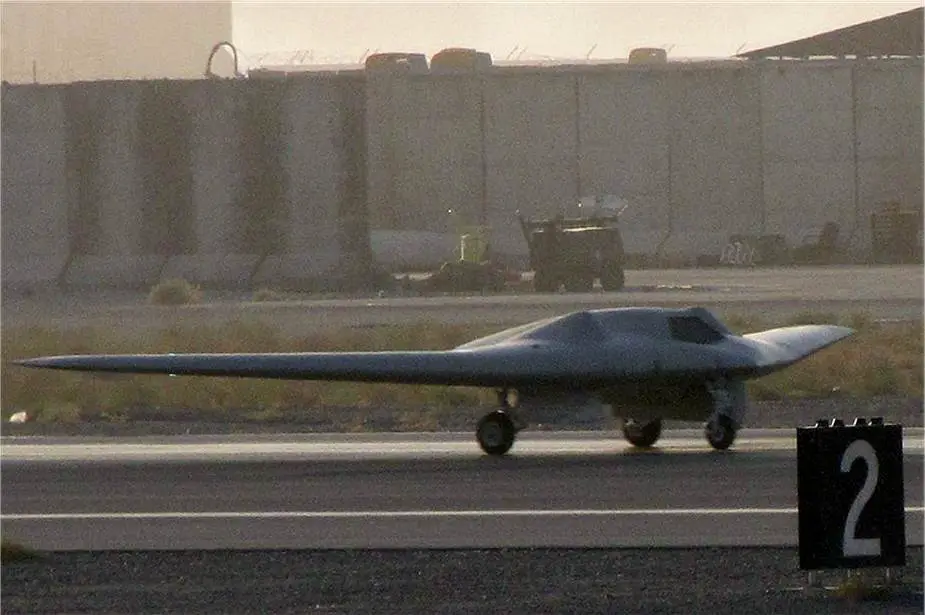Breaking news
US Air Force conducts exercise with F-35 fighter to evaluate air defense of B-2 and RQ-170.
According to information published by the U.S. Air Force on August 6, 2020, the U.S. Force 53d Test and Evaluation Group planned and executed a $1.4 million Large Force Test Event (LFTE), August 4-6, 2020, designed to find solutions to Air Force prioritized Tactics Improvement Proposals for Suppression of Enemy Air Defense, low-observable ingress, and 4th-5th generation electronic attack interoperability. Principally, this LFTE assessed the tactics and viability of the F-35 to provide enhanced SEAD support to LO platforms, including the B-2 and RQ-170, within an operationally realistic environment.
Follow Air Recognition on Google News at this link
 U.S. Air Force RQ-170 Sentinel stealth drone (Picture source Robohub.org )
U.S. Air Force RQ-170 Sentinel stealth drone (Picture source Robohub.org )
During this exercise, newer 4th generation platform capabilities were also evaluated in the LFTE (Large Force Test Event). Some scenarios tested 4th and 5th generation Joint and Coalition SEAD (Suppression of Enemy Air Defenses) integration contacts, while others examined how the latest unique 4th generation electronic attack capabilities can increase 5th generation freedom of maneuver in contested environments and vice versa.
Participants included the F-35A, F-22, and F-15E from the 422nd Test and Evaluation Squadron; the B-2 from the 72nd Test and Evaluation Squadron; the RQ-170 from the 44th Reconnaissance Squadron; the E/A-18G from the Navy’s VX-9 and Naval Aviation Warfighting Development Center; and command and control from the 605th Test and Evaluation Squadron. This unique combination of joint platforms maximized the development and evaluation of a combat-relevant capabilities.
LFTEs are Air Combat Command’s principal event for operational test warfighters to evaluate the suitability and effectiveness of emerging capabilities within an integrated and operationally realistic scenario. Unlike joint or multiple-platform exercises that focus on the training and readiness for units with fielded capabilities, such as Red Flag, LFTEs focus on yet to be fielded hardware, software, and tactics. Results from LFTEs inform a wide range of efforts to include capability development and the latest tactics, with a focus on integration.
The B-2 Spirit, also known as the Stealth Bomber, is an American heavy strategic bomber, featuring low observable stealth technology designed by the Company Northrop Grumman. The B-2 provides the penetrating flexibility and effectiveness inherent in manned bombers. Its low-observable, or "stealth," characteristics give it the unique ability to penetrate an enemy's most sophisticated defenses and threaten its most valued, and heavily defended, targets. Its capability to penetrate air defenses and threaten effective retaliation provides a strong, effective deterrent and combat force well into the 21st century.
The B-2 is able to carry up to 18,000 kg of weapons, including conventional and nuclear weapons, precision-guided munitions, gravity bombs and a range of maritime weapons.
The RQ-170 Sentinel (colloquially known as The Beast of Kandahar) is an unmanned aerial vehicle (UAV) developed by Lockheed Martin and operated by the United States Air Force (USAF) for the Central Intelligence Agency. While the USAF has released few details on the UAV's design or capabilities, defense analysts believe that it is a stealth aircraft fitted with reconnaissance equipment.
According to information released on Internet, RQ-170 Sentinel is fitted with an active electronically scanned array radar, synthetic aperture radar and signal intelligence in its belly fairings. It also has electro-optic and infra-red sensors that are incorporated in the upper surface of the wings.



















